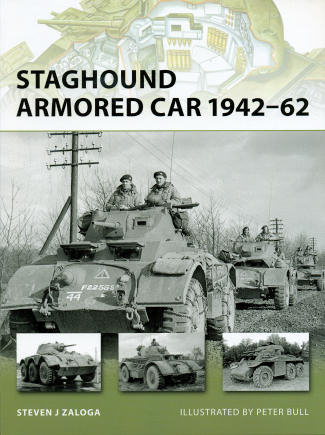 I'm one
of those modelers who, when it comes time to do a military vehicle kit, will
generally go with one that doesn't have tracks. In fact, armored cars are my
favorite subject in this genre and one of the nicest is the Staghound. The
Staghound was part of a US Army 1940 requirement that included light, medium and
heavy armored cars. The war in the desert was getting the most attention so the
emphasis was on speed and range. For the medium category, there were several
designs submitted and several requests for prototypes. The weeding out brought
things down to two; Ford's T17 Deerhound and Cheverolet's T17E Staghound. Thanks
to the unreliability of the Ford, the Chevrolet version was chosen as the
winner.
I'm one
of those modelers who, when it comes time to do a military vehicle kit, will
generally go with one that doesn't have tracks. In fact, armored cars are my
favorite subject in this genre and one of the nicest is the Staghound. The
Staghound was part of a US Army 1940 requirement that included light, medium and
heavy armored cars. The war in the desert was getting the most attention so the
emphasis was on speed and range. For the medium category, there were several
designs submitted and several requests for prototypes. The weeding out brought
things down to two; Ford's T17 Deerhound and Cheverolet's T17E Staghound. Thanks
to the unreliability of the Ford, the Chevrolet version was chosen as the
winner.
However, the Army was having a real re-think about things and
decided that they didn't really want a medium or even heavy armored car, instead
going for the M8 Greyhound, a light armored car. These were not lightweights
with the medium class weighing in at about 14 tons. However, the British were
very interested and put in an order for several thousand of them. In fact, aside
from a few handfuls of Staghounds kept in the US for testing, the entire
production run went overseas.
By the time these reached the front lines in 1943, the war in
the desert was over and so was the real need for a fast moving, long range,
somewhat heavy armored car. Those units in Italy who first got the Staghound
spent little time using it as designed as most of the fighting was over rugged
mountainous terrain, an area not suited for the Staghound. When the chance for
open running was provided, as in later in the war in Italy and during the
Normandy breakout in France, the Staghound did superbly.
The British didn't particularly like it as it was so large,
going with the Dingo in most cases. This meant that Commonwealth units were
those that made the most use of it. In fact, the Canadians were particularly
attracted to it as it required so little in the way of maintenance. According to
records, the time to get one up and running in the morning was about 10-15
minutes, while daily maintenance on the Dingo was in the 1-3 hour range. Postwar
the Staghound was used by many Allied nations and found use in many other places
around the world including Israel, Cuba and Nicaragua.
Author Steven J. Zaloga is widely acknowledged as one of the
foremost authorities on armor and has put his expertise to use in this book.
Each type of vehicle as well as its development history is well covered and his
writing style makes for interesting reading. When you add to it the quality period photographs and the
superb artwork of illustrator Peter Bull, you have an excellent quick reference
on a most intriguing subject. It is a book that I can most highly recommend to the enthusiast and modeler
alike.
October 2009
For more on the complete line of Osprey books,
visit www.ospreypublishing.com. In the US, it is
Osprey Direct at 44-02 23rd St, Suite 219, Long Island City, NY 11101., where you can
get a catalogue of available books.
If you would like your product reviewed fairly and quickly, please contact
me or see other details in the Note to
Contributors.
 I'm one
of those modelers who, when it comes time to do a military vehicle kit, will
generally go with one that doesn't have tracks. In fact, armored cars are my
favorite subject in this genre and one of the nicest is the Staghound. The
Staghound was part of a US Army 1940 requirement that included light, medium and
heavy armored cars. The war in the desert was getting the most attention so the
emphasis was on speed and range. For the medium category, there were several
designs submitted and several requests for prototypes. The weeding out brought
things down to two; Ford's T17 Deerhound and Cheverolet's T17E Staghound. Thanks
to the unreliability of the Ford, the Chevrolet version was chosen as the
winner.
I'm one
of those modelers who, when it comes time to do a military vehicle kit, will
generally go with one that doesn't have tracks. In fact, armored cars are my
favorite subject in this genre and one of the nicest is the Staghound. The
Staghound was part of a US Army 1940 requirement that included light, medium and
heavy armored cars. The war in the desert was getting the most attention so the
emphasis was on speed and range. For the medium category, there were several
designs submitted and several requests for prototypes. The weeding out brought
things down to two; Ford's T17 Deerhound and Cheverolet's T17E Staghound. Thanks
to the unreliability of the Ford, the Chevrolet version was chosen as the
winner.